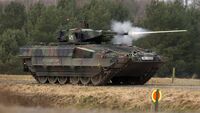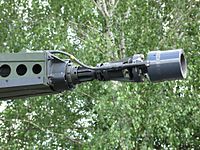BVP-40 Panter: Difference between revisions
(→Design) |
|||
| Line 56: | Line 56: | ||
The Panter employs a number of state of the art technologies in its design. In order to improve crew communication and easy mobility in the interior, the crew compartment is designed as monoblock, making it fairly compact, with the only exception being the driver station protruding forward, under the autocannon. The cabin is fully NBC protected, with nuclear and chemical sensors, whilst retaining two zone air conditioning for both crew and passenger compartments. The fire suppression system uses non-toxic agents in the cabin, while additional system is found in the engine compartment. In order to preserve a compact, monoblock design of the crew compartment, Panter hosts an unmanned, double-asymmetrical turret that is located on the left side of the vehicle, while the autocannon is mounted on the right side of the turret, making it aligned to the middle axis of the hull when facing forward. | The Panter employs a number of state of the art technologies in its design. In order to improve crew communication and easy mobility in the interior, the crew compartment is designed as monoblock, making it fairly compact, with the only exception being the driver station protruding forward, under the autocannon. The cabin is fully NBC protected, with nuclear and chemical sensors, whilst retaining two zone air conditioning for both crew and passenger compartments. The fire suppression system uses non-toxic agents in the cabin, while additional system is found in the engine compartment. In order to preserve a compact, monoblock design of the crew compartment, Panter hosts an unmanned, double-asymmetrical turret that is located on the left side of the vehicle, while the autocannon is mounted on the right side of the turret, making it aligned to the middle axis of the hull when facing forward. | ||
===Armament=== | ===Armament=== | ||
[[File:Panter firing weapon.jpg|thumb|left|200px|BVP-40 Panter of the [[Nikolian Royal Army]] firing its 30mm autocannon]] | |||
[[File:MK30-2-ABM-muzzle.JPG|thumb|left|200px|Filipovski MPK-40, measurement and programming component of the autocannon. The device consists of coils for inductive measurement of the projectile's initial velocity and for programming the electronic fuze.]] | |||
The Panter is primarily armed with a 30mm [[Filipovski AT mod.3040]] produced by the Nikolian [[Filipovski Weapons Systems]] with a rate of fire of 200 rounds per minute and effective range of up to 3,000 meters. The designers opted for a smaller 30x173mm cartridge and a belt feed system to reduce weight and increase ammo loadout. The dual belt feed system supplies the autocannon with two types of ammunition: sub-caliber, fin stabilised {{wp|APFSDS}}-T high penetration rounds and full caliber, multi purpose Kinetic Energy-Timed Fuse (KETF) rounds with air burst capability. The round type can be selected on shot by shot basis, thanks to the open bolt system of the autocannon. | |||
Secondary armament is [[LMP 2000|LMP 2000SM]] 7.62mm coaxial machine gun with ammo capacity of 2,000 rounds and an effective range of up to 1,000 meters. | |||
In addition to the autocannon, the Panter is equipped with a turret-mounted [[Pijl R]] ATGM launcher with two missiles ready to fire and additional 4 in storage. The Pijl R has an effective range of 4,000 meters and is designed to defeat heavy armoured targets like tanks, bunkers and infrastructure. The missile can be launched in two modes: Fire and Forget and Fire and Observe. | |||
For close-in defense, Panter is equipped with 6-round 76mm grenade launcher fitted at the back of the vehicle. | |||
===Protection=== | ===Protection=== | ||
Revision as of 14:57, 20 May 2020
This article is incomplete because it is pending further input from participants, or it is a work-in-progress by one author. Please comment on this article's talk page to share your input, comments and questions. Note: To contribute to this article, you may need to seek help from the author(s) of this page. |
| BVP-40 Panter Igv 40 Panter | |
|---|---|
 BVP-40 Panter of the Nikolian Royal Army | |
| Type | Infantry fighting vehicle |
| Place of origin | Nikolia, Noordenstaat |
| Service history | |
| In service | 2012-present |
| Used by | |
| Production history | |
| Designer | NORNIK Group |
| Designed | 1997-2011 |
| Manufacturer | NORNIK Group |
| Unit cost | 9.7 million NSD |
| Produced | 2011-present |
| Specifications | |
| Weight | 31.4t (A variant) 43t (B variant) |
| Length | 7.6 m (25 ft) |
| Width | 3.9 m (13 ft) (With additional armour) |
| Height | 3.6 m (12 ft) |
| Crew | 3 + 6 |
| Armor | Modular composite armour |
Main armament | 30mm Filipovski AT mod.3040 autocannon with 400 rounds |
Secondary armament | 7.62mm LMP 2000SM 2,000 rounds Pijl R anti-tank guided missile 6-round 76mm grenade launcher |
| Engine | FMK-8011DV V10 diesel, 11.1 litres 800 kW (1,100 hp) at 4,250 r/min |
| Power/weight | 18.6 kW/t |
| Suspension | Hydropneumatic |
Operational range | 460 km |
| Speed | 70 km/h (road) |
The BVP-40/Igv 40 Panter (Serbian: Borbeno vozilo pešadije ;BVP; Dutch: Infanteriegevechtsvoertuig ;Igv) is infantry fighting vehicle co-developed and built by Nikolian and Noordenstaatian joint venture company NORNIK Group.
The first production of the vehicle started in 2011 with the initial order of 400 units for Nikolia and 300 units for Noordenstaat, while additional orders were placed for a total of around 2,500 units to be produced.
The Panter is a result of a successful, long lasting partnership between Nikolia and Noordenstaat that produced several other military vehicles and hardware now in use by both armies. Thanks to its powerful 800kW (1,100hp) engine, providing for high power-to-weight ratio, the Panter is fitted with additional armour plates and state of the art protection systems, which makes it one of the most protected IFVs in the world.
Development
Design
The Panter employs a number of state of the art technologies in its design. In order to improve crew communication and easy mobility in the interior, the crew compartment is designed as monoblock, making it fairly compact, with the only exception being the driver station protruding forward, under the autocannon. The cabin is fully NBC protected, with nuclear and chemical sensors, whilst retaining two zone air conditioning for both crew and passenger compartments. The fire suppression system uses non-toxic agents in the cabin, while additional system is found in the engine compartment. In order to preserve a compact, monoblock design of the crew compartment, Panter hosts an unmanned, double-asymmetrical turret that is located on the left side of the vehicle, while the autocannon is mounted on the right side of the turret, making it aligned to the middle axis of the hull when facing forward.
Armament

The Panter is primarily armed with a 30mm Filipovski AT mod.3040 produced by the Nikolian Filipovski Weapons Systems with a rate of fire of 200 rounds per minute and effective range of up to 3,000 meters. The designers opted for a smaller 30x173mm cartridge and a belt feed system to reduce weight and increase ammo loadout. The dual belt feed system supplies the autocannon with two types of ammunition: sub-caliber, fin stabilised APFSDS-T high penetration rounds and full caliber, multi purpose Kinetic Energy-Timed Fuse (KETF) rounds with air burst capability. The round type can be selected on shot by shot basis, thanks to the open bolt system of the autocannon.
Secondary armament is LMP 2000SM 7.62mm coaxial machine gun with ammo capacity of 2,000 rounds and an effective range of up to 1,000 meters.
In addition to the autocannon, the Panter is equipped with a turret-mounted Pijl R ATGM launcher with two missiles ready to fire and additional 4 in storage. The Pijl R has an effective range of 4,000 meters and is designed to defeat heavy armoured targets like tanks, bunkers and infrastructure. The missile can be launched in two modes: Fire and Forget and Fire and Observe.
For close-in defense, Panter is equipped with 6-round 76mm grenade launcher fitted at the back of the vehicle.
